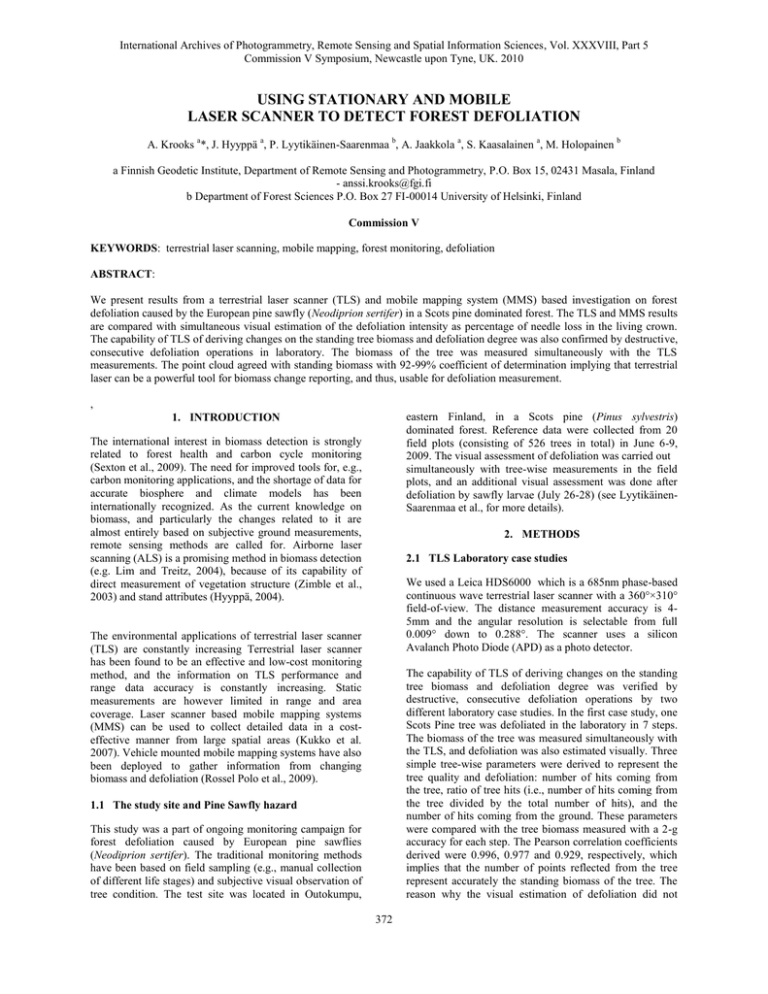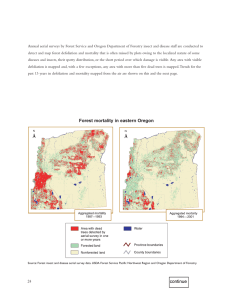International Archives of Photogrammetry, Remote Sensing and Spatial Information Sciences,...
advertisement

International Archives of Photogrammetry, Remote Sensing and Spatial Information Sciences, Vol. XXXVIII, Part 5 Commission V Symposium, Newcastle upon Tyne, UK. 2010 USING STATIONARY AND MOBILE LASER SCANNER TO DETECT FOREST DEFOLIATION A. Krooks a*, J. Hyyppä a, P. Lyytikäinen-Saarenmaa b, A. Jaakkola a, S. Kaasalainen a, M. Holopainen b a Finnish Geodetic Institute, Department of Remote Sensing and Photogrammetry, P.O. Box 15, 02431 Masala, Finland - anssi.krooks@fgi.fi b Department of Forest Sciences P.O. Box 27 FI-00014 University of Helsinki, Finland Commission V KEYWORDS: terrestrial laser scanning, mobile mapping, forest monitoring, defoliation ABSTRACT: We present results from a terrestrial laser scanner (TLS) and mobile mapping system (MMS) based investigation on forest defoliation caused by the European pine sawfly (Neodiprion sertifer) in a Scots pine dominated forest. The TLS and MMS results are compared with simultaneous visual estimation of the defoliation intensity as percentage of needle loss in the living crown. The capability of TLS of deriving changes on the standing tree biomass and defoliation degree was also confirmed by destructive, consecutive defoliation operations in laboratory. The biomass of the tree was measured simultaneously with the TLS measurements. The point cloud agreed with standing biomass with 92-99% coefficient of determination implying that terrestrial laser can be a powerful tool for biomass change reporting, and thus, usable for defoliation measurement. , eastern Finland, in a Scots pine (Pinus sylvestris) dominated forest. Reference data were collected from 20 field plots (consisting of 526 trees in total) in June 6-9, 2009. The visual assessment of defoliation was carried out simultaneously with tree-wise measurements in the field plots, and an additional visual assessment was done after defoliation by sawfly larvae (July 26-28) (see LyytikäinenSaarenmaa et al., for more details). 1. INTRODUCTION The international interest in biomass detection is strongly related to forest health and carbon cycle monitoring (Sexton et al., 2009). The need for improved tools for, e.g., carbon monitoring applications, and the shortage of data for accurate biosphere and climate models has been internationally recognized. As the current knowledge on biomass, and particularly the changes related to it are almost entirely based on subjective ground measurements, remote sensing methods are called for. Airborne laser scanning (ALS) is a promising method in biomass detection (e.g. Lim and Treitz, 2004), because of its capability of direct measurement of vegetation structure (Zimble et al., 2003) and stand attributes (Hyyppä, 2004). 2. METHODS 2.1 TLS Laboratory case studies We used a Leica HDS6000 which is a 685nm phase-based continuous wave terrestrial laser scanner with a 360°×310° field-of-view. The distance measurement accuracy is 45mm and the angular resolution is selectable from full 0.009° down to 0.288°. The scanner uses a silicon Avalanch Photo Diode (APD) as a photo detector. The environmental applications of terrestrial laser scanner (TLS) are constantly increasing Terrestrial laser scanner has been found to be an effective and low-cost monitoring method, and the information on TLS performance and range data accuracy is constantly increasing. Static measurements are however limited in range and area coverage. Laser scanner based mobile mapping systems (MMS) can be used to collect detailed data in a costeffective manner from large spatial areas (Kukko et al. 2007). Vehicle mounted mobile mapping systems have also been deployed to gather information from changing biomass and defoliation (Rossel Polo et al., 2009). The capability of TLS of deriving changes on the standing tree biomass and defoliation degree was verified by destructive, consecutive defoliation operations by two different laboratory case studies. In the first case study, one Scots Pine tree was defoliated in the laboratory in 7 steps. The biomass of the tree was measured simultaneously with the TLS, and defoliation was also estimated visually. Three simple tree-wise parameters were derived to represent the tree quality and defoliation: number of hits coming from the tree, ratio of tree hits (i.e., number of hits coming from the tree divided by the total number of hits), and the number of hits coming from the ground. These parameters were compared with the tree biomass measured with a 2-g accuracy for each step. The Pearson correlation coefficients derived were 0.996, 0.977 and 0.929, respectively, which implies that the number of points reflected from the tree represent accurately the standing biomass of the tree. The reason why the visual estimation of defoliation did not 1.1 The study site and Pine Sawfly hazard This study was a part of ongoing monitoring campaign for forest defoliation caused by European pine sawflies (Neodiprion sertifer). The traditional monitoring methods have been based on field sampling (e.g., manual collection of different life stages) and subjective visual observation of tree condition. The test site was located in Outokumpu, 372 International Archives of Photogrammetry, Remote Sensing and Spatial Information Sciences, Vol. XXXVIII, Part 5 Commission V Symposium, Newcastle upon Tyne, UK. 2010 correlate that well with the number of laser hits is that trunks and branches affect the biomass but are ignored in the defoliation estimation. Therefore it can be expected that the visual estimation produces errors larger than those in terrestrial laser scanning. directly visible (i.e., not obscured by other trees) were extracted from the resulting laser point clouds, and the change in the number of laser returns from each tree was compared to the visually estimated defoliation intensity given as percentage of the lost needle biomass of the living crown. In the second laboratory experiment (Fig. 1), five pine (Scots Pine) and spruce (Norway spruce) trees were measured with TLS from above and below. Here too the biomass of the tree was measured simultaneously with 2-g accuracy. The coefficient of determination with a linear regression model was 0.92 for total biomass and 0.98 for needle and branch biomass, which implies that the relative number of points reflected from the tree represent accurately the relative standing biomass of the tree. Figure 3: Visual and TLS-based measurement of forest defoliation (in percentages). Figure 1: Defoliation time series from laboratory test derived from TLS scan files The change in laser returns from the tree canopy (in percentages) between the measurements in June 25 and July 26-27 is presented in Figure 3 and compared with visual observation. Clear trends of defoliation are visible in both visual and TLS-based analysis of the tree canopies. There are however several factors that affect the accuracy, e.g., - - - Figure 2: Normalized laser point number versus normalized total biomass of the trees from second laboratory experiment. R2=0.95. - 2.2 TLS Field Experiment Deviation in change detection from TLS point clouds (e.g. mixed pixel effect with phase shift based laser scanners) The first visual estimation was carried out in June 6-9, i.e. two weeks before the first TLS measurements. The visual estimation of defoliation may be subjective, and it is not based on change detection rather than comparing the present situation with an ideal one (the crown is healthy by soil condition is taken into account). The ground-based TLS measurement is made in the upward direction, preventing some parts of the canopy from being measured. Airborne measurements facing downwards would improve the accuracy. 2.3 MMS Field Experiment The mobile mapping system used in this study was a low cost approach combining pulse based laser scanner ibeo LUX and Novatel SPAN inertial measurement unit (IMU) + a GPS -unit. The ibeo scanner uses pulsed laser beam at 895-910 nm and has field of view 85° x 3.2° with 4 parallel beams. The scanner was mounted on the roof of a car (Fig. 4.) and the sample data was collected by driving along the Two sets of TLS measurements were carried out in the study site in June 25 and July 26-27 during the active period of the pine sawfly hazard. The first measurement was made at the early phases of defoliation and the second one after defoliation period. The scanning was performed from the centre of each field plot with similar scanning parameters and resolution at both dates. The trees that were 373 International Archives of Photogrammetry, Remote Sensing and Spatial Information Sciences, Vol. XXXVIII, Part 5 Commission V Symposium, Newcastle upon Tyne, UK. 2010 test plots. GPS-IMU solution was post calculated using virtual reference station (VRS-GPS). used mobile laser scanner parallel with TLS and visual defoliation estimation. First results from the MMS data point out potential of using mobile laser scanner as defoliation trends were visible in data and with mobile platform data collection can be done in very efficient manner. The MMS data (Fig. 5.) comparison to TLS data and visual interpretation was done with three sample plots. Change in laser returns from the canopy was determined comparing canopy returns to trunk returns as laser point density in target depends on vehicle movement. Early results from the data point out that defoliation trends were similarly visible as with TLS measurements. MMS data has however different error sources. Large laser footprint and shadowing effect from non-test sample trunks makes it difficult to detect small changes in test tree canopy biomass. REFERENCES Hyyppä, J. 2004. Method for Determination of Stand Attributes and a Computer Program to Perform the Method, U.S. Patent No. 6,792,684. Kukko, A., Constantin-Octavian, A., Salminen, V-M., Kaarinen, H., Chen, Y., Rönnholm, P., Hyyppä, H., Hyyppä, J., Chen, R., Haggrén, H., Kosonen, I., Čapek, K. 2007. Road environment mapping system of the Finnish Geodetic Institute – FGI Roamer. In: International Archives of Photogrammetry, Remote Sensing and Spatial Information Sciences, 36(3/W52), 241-247. Lim, K.S. and P.M. Treitz, 2004. Estimation of above ground forest biomass from airborne discrete return laser scanner data using canopy-based quantile estimators. Scandinavian Journal of Forest Research, 19(6): 558-570. Lyytikäinen-Saarenmaa, P., Varama, M., Anderbrant, O., Kukkola, M., Kokkonen, A.-M., Henderström, E., and Högberg, H.-E., 2006. Monitoring the European pine sawfly in maturing Scots pine stands with pheromone traps. Agricultural and Forest Entomology, 8, pp. 7-15. Figure 4: The MMS system mounted on car Jaakkola, A., Hyyppä, J., Hyyppä, H., Kukko, A., 2008. Retrieval Algorithms for Road Surface Modelling Using Laser-Based Mobile Mapping. Sensors, 8(9), pp. 52385249. Rossel Polo, J., Sanz, R, Llorens, J., Arnó, J., Escolà, A., Ribes-Dasi, M., Masip, J., Camp, F., Gràcia, F., Solannes, F., Pallejà, T., Val, L., Planas, S., Gil, E., Palacín, J. 2009. A tractor-mounted scanning LIDAR for the non-destructive measurement of vegetative volume and surface area of treerow plantations: A comparison with conventional destructive measurements. Biosystems Engineering, 102, pp. 128-134 Figure 5: Point cloud derived from MMS data Sexton, J.O., Bax, T., Siqueira, P., Swenson, J. J., and Hensley, S., 2009. A comparison of lidar, radar, and field measurements of canopy height in pine and hardwood forests of southeastern North America. Forest Ecology and Management 257(3), pp. 1136-1147. 3. CONCLUSIONS The defoliation trend was visible in the TLS laboratory and field experiments, although correlation between point cloud and biomass was much better in laboratory experiments. Future tests will show whether the effect of the trunk is important. The results explain why airborne laser scanning (ALS) is effective for stem volume estimation, since the number of hits recorded by ALS is most probably highly correlated with the biomass, especially needle and branch biomass, which in turn correlated highly with the stem volume. Future tests are needed to verify this, but it can be assumed that a laser scanner measures tree height, crown area and biomass with a high accuracy. In this study we Zimble, D.A., Evans, D.L., Carlson, G.C., Parker, R.C., Grado, S.C. and P.D. Gerard, 2003. Characterizing vertical forest structure using small-footprint airborne LiDAR. RS of Environ. 87(2-3): 171-182. 374




